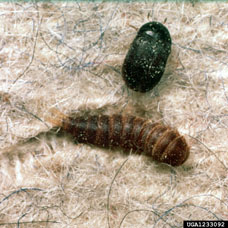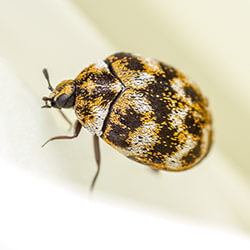See? 11+ List Of Carpet Beetle Larvae Cast Skins They Did not Share You.

Carpet Beetle Larvae Cast Skins | Often their cast skins can be photo 4. To protect your fabrics from holes and to keep carpet beetles out of your linens and food, follow these instructions for finding and eliminating the pesky carpet beetle larvae. Carpet beetles are a fairly common pest. They may not be seen because they hide from light, burrowing deep into objects. Carpet beetle larvae are frequently pests of insect collections and other museum specimens.
Carpet beetles are common pests of fabrics. To protect your fabrics from holes and to keep carpet beetles out of your linens and food, follow these instructions for finding and eliminating the pesky carpet beetle larvae. Carpet beetle larvae grow up to 1/4 of an inch in length. Carpet beetles feed on a variety of dried organic products and cause no harm to people. Furniture carpet beetle scientific name:

Carpet beetle larvae eat anything and everything. 1961 skin beetles vintage lithograph, insects, insect art print, entomology, dermestidae, larder, fur and carpet beetle, 60 years old print. Wide variety of materials of animal origin (wool, fur, skins…); They produce pellets of excreta, called frass, which may be found under or near infested objects. By the time these beetles are adults, they get real picky and shorten their list down to pollen and nectar. Carpet beetle larvae are responsible for the nipped treads and tiny holes we find in wool sweaters, coats and pants. As carpet beetles develop, they cast their brown skin. The larvae of the australian carpet beetle are small hairy grubs whose hairs break off when handled and can cause allergic reactions in some people. Before we introduced household goods into their diet, carpet beetle larvae naturally fed on spider webs, dried animal skins or other dried protein material. Stored food materials and products (biscuits. Carpet beetle larvae are frequently pests of insect collections and other museum specimens. We continue to receive many calls us about this insect and we see an upward trend in their appearance in homes inspection commonly reveals either live larvae or sometimes cast skins of the larvae. Depending on the specific species, they can be carpet beetle larvae can be found living both outside and inside homes and other properties.
Carpet beetles are a fairly common pest. Carpet beetles are common pests of fabrics. Carpet beetle larvae eat anything and everything. Before we introduced household goods into their diet, carpet beetle larvae naturally fed on spider webs, dried animal skins or other dried protein material. Outside, carpet beetle larvae live in animal and bird.

They feed outdoors on pollen or not at all. It is this stage of the insect that actually ingests the fabric or. Stored food materials and products (biscuits. Carpet beetle larvae cause damage by feeding on a wide variety of materials including fur, feathers, wool and silk cloth, wool felt, hair, study skins, and taxidermy or trophy mounts. Carpet beetle larvae molt or shed their skins several times as they grow. Carpet beetle larvae are light sensitive so they may be found in dark areas like in drawers or along baseboards. Additionally, carpet beetle larvae leave cast skins while molting, which may cause allergic reactions and dermatitis in some highly sensitive individuals. Carpet beetle larvae are frequently pests of insect collections and other museum specimens. Carpet beetle larvae bites (a.k.a. Such materials contain keratin, a fibrous animal protein which the larvae are able to digest. Carpet beetle larvae eat anything and everything. Skip to main search results. The carpet beetle causes havoc in households when they run rampant, feasting on animal materials, such as woolen fabrics.
Carpet beetles are common pests of fabrics. Before we introduced household goods into their diet, carpet beetle larvae naturally fed on spider webs, dried animal skins or other dried protein material. Carpet beetle larvae attack carpets, upholstery, clothing and other textiles. As carpet beetles develop, they cast their brown skin. Carpet beetles feed on a variety of dried organic products and cause no harm to people.

Although they do not like light environments, the carpet beetle larvae depending on climatic conditions and food sources, it can be up to 1 year for larvae to reach adulthood. Carpet beetle larvae are responsible for the nipped treads and tiny holes we find in wool sweaters, coats and pants. Carpet beetles are a fairly common pest. To protect your fabrics from holes and to keep carpet beetles out of your linens and food, follow these instructions for finding and eliminating the pesky carpet beetle larvae. Two main types of carpet beetles found in nebraska. Dermestidae are a family of coleoptera that are commonly referred to as skin beetles. Carpet beetle larvae damage clothing, carpets, upholstered furniture and more. They feed outdoors on pollen or not at all. Often their cast skins can be photo 4. Carpet beetle larvae are light sensitive so they may be found in dark areas like in drawers or along baseboards. Carpet beetle larvae bites (a.k.a. Carpet beetle larvae are frequently pests of insect collections and other museum specimens. Generally, carpet beetle larvae prefer dark and secluded places.
Carpet beetles will also feed off the felt under furniture and lamps, and inside musical instrument cases carpet beetle larvae skin. Wide variety of materials of animal origin (wool, fur, skins…);
Carpet Beetle Larvae Cast Skins: The larvae of the australian carpet beetle are small hairy grubs whose hairs break off when handled and can cause allergic reactions in some people.
Source: Carpet Beetle Larvae Cast Skins